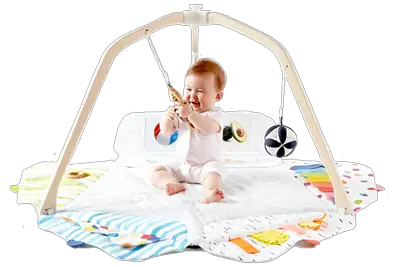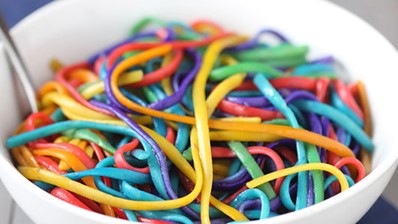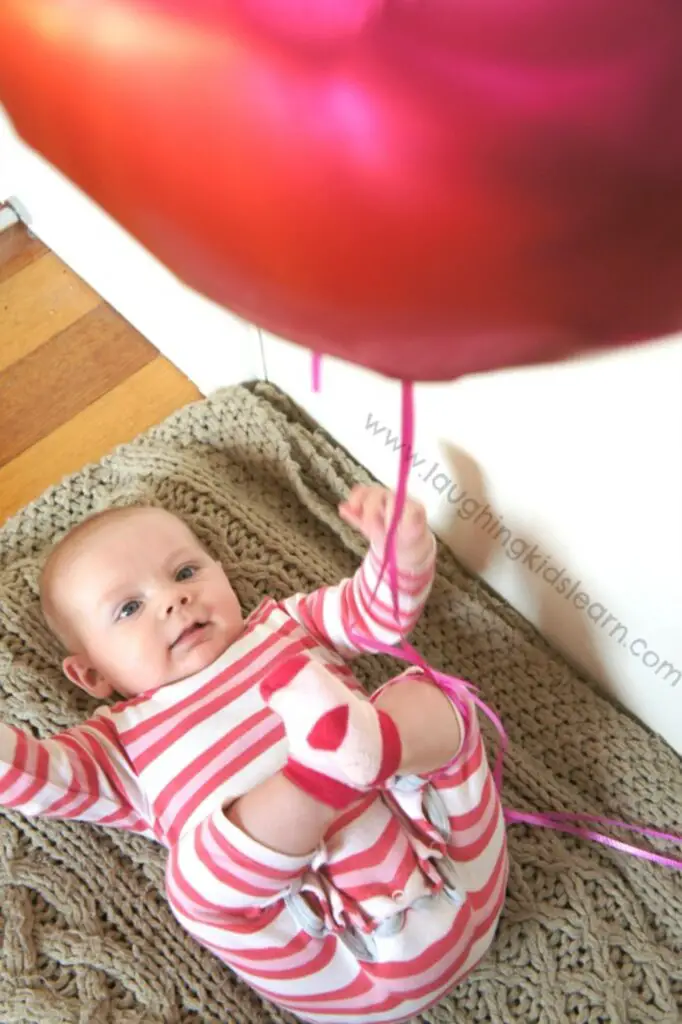Sensory play has become a hot topic as of late. You’ll hear mom groups discussing sensory activities for infants and likely receive advice on sensory activities for toddlers from your pediatrician. But what is sensory play, and why should you do it?
This article will cover the basics of this type of play and talk about the benefit of sensory play. By the end, you’ll know why sensory time is such as great idea and be equipped with some great activities to nurture your little one!
What is Sensory Play?
As you may have guessed, sensory play involves the five senses: sight, smell, sound, touch, and taste. It also uses other forms of body awareness, such as balancing and spatial awareness. These are known as your vestibular and proprioceptive systems, respectively.
Sensory activities engage all of these senses and systems and help your child develop motor, language, cognitive, and social skills and build their self-esteem.
Sensory play can include musical toys, art supplies, toys with tactile interest like dried noodles, Montessori toys for babies, and so much more. Anything that has the capability to engage your child’s senses can be used for infant and toddler sensory activities.
About Sensory Activities
Sensory play for toddlers and babies doesn’t require a particular area like a Montessori playroom or specific items. It’s relatively easy to create sensory activities that you can do in your own home.
Sensory bins are one of the best and easiest because they can engage many senses. Fill a container with water, Easter grass, packing peanuts, or any other safe material. Then, let your child explore. They’ll be able to feel the items, listen to the sounds they make, see them, and maybe even smell them.
Other sensory activities that engage the proprioceptive and vestibular systems can work well as outdoor games for toddlers. Such as playing hopscotch, rolling in the grass, or swinging on a swing.
Even playing with food can be a sensory play activity. Think about making applesauce; your child can taste, touch, listen, smell, and see the various parts of this process.
Sensory activities can be as calming as they are exciting. Water play, in particular, can be very soothing for little ones. While it activates their sense, it can also help soothe them. While we don’t always understand why babies cry and how to soothe them, trying some sensory time, like a bath, might help!
How Sensory Play Can Benefit Your Little One
We’ve mentioned that sensory play helps engage the senses and bodily systems, increasing development in many areas. But let’s take a closer look at the benefits of sensory play.
Infant and toddler learning activities can:
- Build fine motor skills. Fine motor skills can be fostered through sensory play with small objects, such as picking up cheerios or tying a shoe. Additionally, doughs and slimes can help strengthen small muscles and help with coordination.
- Boost language skills. Learning through experiences and interactions with their environment is essential for language. You can ask your little one to describe what they’re hearing, tasting, or smelling.
- Improves gross motor skills. Big movements, like crawling and jumping, can be enhanced through sensory play that strengthens large muscles. Think of outdoor activities like throwing a ball or rolling down a hill.
- Improves cognitive function. Sensory play causes your child to wonder how things work, problem solve, and think about how things feel or make them feel. They’ll learn by exploring and working through challenges; for example, moving cheerios from one container to another.
- Improves social skills. Sensory play with others is a great way to build social skills. They’ll be required to share, work together to solve challenges, and communicate with one another.
- It can be calming. Sensory play can be very calming for some children. Hearing the sound of water, running their hands over feathers, or swinging can have a soothing effect while appealing to the senses.
Ideas for Sensory Play Activities
Sensory Activities for Infants
1. Play Gym
A baby play gym is one of the easiest sensory play ideas. Include a gym with lots to see, touch, and listen to. Playing gyms that light up or make noise when your child kicks or swats is also a great way to include sensory and make tummy time fun.

2. Colorful Pasta
Older babies will love to explore cooled pasta cooked with food coloring, making it all colors of the rainbow. This sensory activity will delight many of the senses and is great for messy sensory play that’s so much fun but still easy cleanup.

3. No Mess Painting
We love this art project for infants. Fill a large, gallon Ziploc with just enough paint to cover the entire area when laid flat. Then, tape the top to your child’s high chair tray. As they drag their finger over the outside of the bag, it will leave a trail in the paint, like they’re drawing!

4. DIY Sensory Board
Using a plastic serving tray, board, or recycled materials, you can make a sensory board for little ones. Glue on a variety of materials that they can feel and explore (but not rip off), such as pom poms, plastic straws, googly eyes, and bubble wrap.

5. Starry Night Sky
If you have a large cardboard box, your little one can safely sit or lay in and poke numerous holes in the top using something like a screwdriver. Then, pop string lights (one light per hole) through the hole you made.
Turn them on and let your little one gaze at the stars. They can even try reaching up to work on their balance and coordination.

6. Sensory Pan or Basket
Babies will be more than happy exploring a basket or shallow pan filled with sensory objects. You can include large pom poms, feathers, or beaded necklaces; just be sure to always supervise.

7. Baby Sand
Finely crush graham crackers to create edible sand. You can bury fun items within it or let your baby explore without worrying if they eat the sand.

8. Jell-O Excavation
Lay down plastic sensory items, such as a beaded necklace, a toy dinosaur, or a spoon, in a 9×13 baking dish. Then, cover the items with Jell-O, keeping them submerged. When it’s set, let your baby dig through it for one of the most delicious fine motor activities for infants!

9. Safe Temperature Study
It can be tricky to find cognitive development activities for infants, but this one will get them thinking. Fill a plastic bottle with cold water and another with warmer (not hot) water. Tightly secure the lid and let your child explore, feeling the difference between temperatures.

10. Balloon Baby
Very little ones can engage in sensory time too. Tying a helium-filled balloon to your child’s ankle and then laying them on their back will result in lots of giggles. Tracking the balloon works hand-eye coordination and helps build cause-and-effect thinking skills.

11. Bell Bottoms
String jingle bells on some ribbon. Then, secure the ribbon to your little one’s bum or their ankles and let them move around. As they discover that they jingle, they’ll work on movement and balance, making this one of the most fun gross motor activities for infants!

Sensory Activities for Toddlers
12. Sensory Slime
You can make your own slime, which is sensory play in and of itself. But you can also add glitter, beads, and other craft supplies or scents and colors to increase the sensory factor.

13. Ice Excavation
Try freezing a small plastic child’s toy, like an animal or truck, in a cup of water. Then, remove it from the mold and allow your toddler to “excavate” it with safe kitchen utensils and some table salt.

14. Easy Stress Balls
First, decorate the outside of an empty balloon with a permanent marker. Then, fill it with a few tablespoons of cornstarch using a funnel. Tie it closed, and you have an on-the-go sensory activity.

15. Volcano Explosion
Use the classic white vinegar and baking soda experiment to make a volcano explosion (either building a volcano or using a plastic toy). This is a great way to engage many of the senses simultaneously.

16. Touch Tag
Playing gentle touch tag outdoors with friends or family can help improve gross motor and social skills and engage the vestibular (balance) system. Plus, your child will have the sensory experience of the outdoors through this active play.

17. Finger Painting
Finger painting with a rainbow of colors will help fine motor skills while counting towards a messy play sensory experience. Consider using plain yogurt and Kool-Aide mix to make scented and edible finger paints.

18. Calming Sensory Bottle
All you need is a clear bottle with a lid to make a calming “ocean” in a bottle. Fill your bottle with water, cooking oil, glitter, food coloring, and other fun objects, then securely glue the lid on.
Your child will love hearing, watching, feeling, and listening to the contents gently slosh around. It’s a sensory bin alternative that still has all the benefits.

19. Guessing Sticks
Take extra-large Popsicle sticks and raid your craft supply closet. On each stick, glue multiple rows of the same item. Such as buttons, pom poms, dry noodles, or feathers.
Then, have your little one close their eyes and feel each stick, questioning them about the experience and what it could be after presenting each one.

20. Kinetic Sand
If you’re hoping to purchase a simple sensory activity you can pull out whenever, kinetic sand is excellent. The feel is so unique; it’s a great sensory pastime and perfect for sensory bins.

21. Giant Outdoor Bubble Bath
Fill a kiddie pool or inflatable pool with lukewarm water and a bottle of bubble bath. Let your kids don their swimsuits and explore using their hands, buckets, and spoons, or maybe even add a plastic kiddie slide.

Final Thoughts
Hopefully, you feel full of inspiration for creating easy, fun, and enriching sensory ideas for your little one!
Sensory play doesn’t have to be complicated or expensive, whether staying indoors or going out.
What’s your favorite sensory idea? We’d love to hear it in the comments.
–




